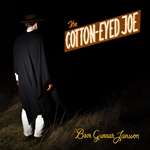
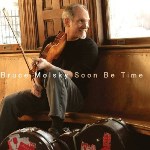
"Cotton-Eyed Joe" (also known as "Cotton-Eye Joe") is a traditional American country folk song popular at various times throughout the United States and Canada, although today it is most commonly associated with the American Southeast.
"Cotton-Eyed Joe" has inspired both a partner dance and more than one line dance that is often danced at country dance venues in the U.S. and around the world. The 1980 film Urban Cowboy sparked a renewed interest in the dance. In 1985, The Moody Brothers' version of the song received a Grammy Award nomination for "Best Country Instrumental Performance". Irish group The Chieftains received a Grammy nomination for "Best Country Vocal Collaboration" for their version of the song with lead vocals by Ricky Skaggs on their 1992 album Another Country. In 1994, a version of the song recorded by the Swedish band Rednex as "Cotton Eye Joe" became popular worldwide.


The origins of this song are unclear, although it pre-dates the 1861–1865 American Civil War. American folklorist Dorothy Scarborough (1878–1935) noted in her 1925 book On the Trail of Negro Folk-songs, that several people remembered hearing the song before the war. Scarborough's account of the song came from her sister, Mrs. George Scarborough, who learned the song from "the Negroes on a plantation in Texas, and other parts from a man in Louisiana". The man in Louisiana knew the song from his earliest childhood and heard slaves singing it on plantations. Both the dance and the song had many variants. American publishing house Harper and Brothers published the first printed version of the song in 1882. It was heard by author Louise Clarke Pyrnelle (born 1850) on the Alabama plantation of her father when she was a child. That 1882 version was republished as follows in 1910:
Cotton-eyed Joe, Cotton-eyed Joe,
What did make you sarve me so,
Fur ter take my gal erway fum me,
An' cyar her plum ter Tennessee?
Ef it hadn't ben fur Cotton-eyed Joe,
I'd er been married long ergo.
His eyes wuz crossed, an' his nose wuz flat,
An' his teef wuz out, but wat uv dat?
Fur he wuz tall, an' he wuz slim,
An' so my gal she follered him.
Ef it hadn't ben fur Cotton-eyed Joe,
I'd er been married long ergo.
No gal so hansum could be foun',
Not in all dis country roun',
Wid her kinky head, an' her eyes so bright,
Wid her lips so red an' her teef so white.
Ef it hadn't ben fur Cotton-eyed Joe,
I'd been married long ergo.
An' I loved dat gal wid all my heart,
An' she swo' fum me she'd never part;
But den wid Joe she runned away,
An' lef' me hyear fur ter weep all day.
O Cotton-eyed Joe, O Cotton-eyed Joe,
What did make you sarve me so?
O Joe, ef it hadn't er ben fur you,
I'd er married dat gal fur true.
By 1884, the same year Mark Twain's Adventures of Huckleberry Finn was published, the fiddle-based song was referred to as "an old, familiar air". In 1925, another version was recorded by folklorist Dorothy Scarborough and published.
Don't you remember, don't you know,
Don't you remember Cotton-eyed Joe?
Cotton-eyed Joe, Cotton-eyed Joe,
What did make you treat me so?
I'd 'a' been married forty year ago
Ef it had n't a-been for Cotton-eyed Joe!
Cotton-eyed Joe, Cotton-eyed Joe,
He was de nig dat sarved me so, —
Tuck my gal away fum me,
Carried her off to Tennessee.
I'd 'a' been married forty year ago
If it had n't a-been for Cotton-eyed Joe.
Hi's teeth was out an' his nose was flat,
His eyes was crossed, — but she did n't mind dat.
Kase he was tall, and berry slim,
An' so my gal she follered him.
I'd 'a' been married forty year ago
Ef it had n't a-been for Cotton-eyed Joe.
She was de prettiest gal to be found
Anywhar in de country round;
Her lips was red an' her eyes was bright,
Her skin was black but her teeth was white.
I'd 'a' been married forty year ago
Ef it had n't a-been for Cotton-eyed Joe.
Dat gal, she sho' had all my love,
An swore fum ne she'd never move,
But Joe hoodooed her, don't you see,
An' she run off wid him to Tennessee,
I'd 'a' been married forty years ago,
Ef it hadn't a-been for Cotton-eyed Joe.
Scarborough noted that the song seemed to be well known in the South prior to the Civil War, and parts of it had been sent in by various persons.
Over the years, many different versions of the song have been performed and/or recorded with many different versions of the lyrics (and many without lyrics). "Cotton-Eyed Joe", on occasion referred to as "The South Texas National Anthem", was played for minstrel-type jigs, and it has long been popular as a square dance hoedown and a couple dance polka.
A resident of Central Texas who learned the dance in Williamson County in the early 1880s described it as nothing but a heel and toe "poker" with fringes added. These fringes added to the heel and toe polka were clog steps which required skill and extraversion on the part of the dancer.
During the first half of the 20th century, the song was a widely known folk song all over English-speaking North America. One discography lists 134 recorded versions released since 1950. In more recent decades, the song has waned in popularity in most regions except some parts of the American South, where it is still a popular folk song.
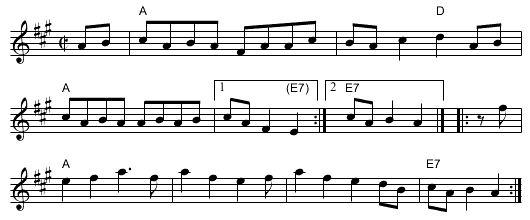
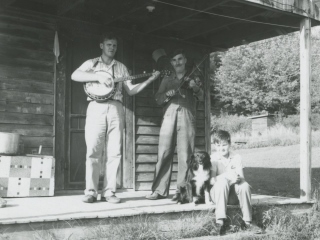
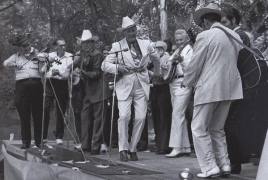
Listen to Cotton-Eyed Joe from: Bruce Molsky, Josh Rouse
Watch & Listen from: Asleep at the Wheel The Chieftains ft. Ricky Skaggs Hot Club of Cowtown Burl Ives Bror Gunnar Jansson Lee Matthews Bruce Molsky Bill Monroe The Mountain Ramblers Rednex Josh Rouse Nina Simone Doc & Merle Watson Bob Wills and his Texas Playboys
A list of the possible meanings of the term "cotton-eyed" that have been proposed includes: to be drunk on moonshine, or to have been blinded by drinking wood alcohol, turning the eyes milky white; a black person with very light blue eyes; someone whose eyes were milky white from bacterial infections of trachoma or syphilis, cataracts or glaucoma; or the contrast of dark skin tone around white eyeballs in black people.
Bob Wills and Adolph Hofner and his San Antonians both recorded the song, and Hofner's version (Columbia 37658), issued in 1941, apparently was the one that did the most to popularize the song.
A 1967 instrumental version of the song (KIKR k202) by Al Dean, who recalled the song called "The Gingerbread Man" in South Texas, inspired a new round dance polka for couples. This dance was adapted into a simplified version as a nonpartner waist-hold, spoke line routine. Heel and toe polka steps were replaced with a cross-lift followed by a kick with two-steps. The lift and kick are sometimes accompanied by shouts of "whoops, whoops", or the barnyard term "bull shit", mimicking the act of kicking off barnyard muck. The practice continues to this day. The Kickin′ album included "Cotton-Eyed Joe" by Dean. (KIK-R: 10012)
One version of a dance called "Cotton-Eyed Joe" can be found in the 1975 edition of Encyclopedia of Social Dance. This version has the men on the inside of a circle facing out, and the women on the outside facing in. The dance consists of eight kick steps, side, close left together, right together, and a series of struts.
In Finland the song is commonly used as the music for a dance called "Teksasin ruusu" in Vanhojen Tanssit.
The spoke line version gained popularity not only in Texas, but also across the US and overseas in the 1980s.
Ray Benson of the Western Swing band Asleep at the Wheel talks about playing the Bob Wills version of "Cotton-Eyed Joe" in Texas in the 1970s when the dance was very much alive.
A Western "craze" followed the 1980 release of Urban Cowboy.
"Cotton-Eyed Joe", and its continued popularity in Texas, was referred to in the lyrics to Alabama's song "If You're Gonna Play in Texas". "I remember down in Houston we were puttin' on a show when a cowboy in the back stood up and yelled, 'Cotton-Eyed Joe'!"
In Merle Haggard's "Texas Fiddle Song", the final verse makes reference to the "Cotton-Eyed Joe" and features the melody of both the Bob Wills and Al Dean versions.
The song has become a staple song played at many professional and college baseball games during the seventh-inning stretch with the preference going to the Rednex version.
In August 1994, Swedish Eurodance group Rednex covered the song as "Cotton Eye Joe" for their album Sex & Violins, combining their style with traditional American instruments, such as banjos, and fiddles. In 2002, "Cotton Eye Joe" was remixed in a dance version, and was released from Rednex's greatest hits album, The Best of the West.
The Rednex version of the song (using "Eye" instead of "Eyed"), along with a dance-mix version, was very successful in Europe, where it remained at number one in Norway for 15 weeks, Switzerland for 13 weeks, Germany for 10 weeks, Sweden for 8 weeks, Austria for 7 weeks, 3 weeks on the UK Singles Chart and 2 weeks on the Dutch Top 40. In Oceania, it topped the New Zealand Singles Chart for 6 consecutive weeks. In Australia it peaked at number 8 in April 1995. In the US, it peaked at number 25 in March 1995.
The Country and Irish singer Lee Matthews released his version of the song with new added lyrics. The single on his own independent label topped the Irish Country Singles Download Chart in January 2015.

Text is available under the Creative Commons Attribution-ShareAlike License.
Date: May 2020.
Photo Credits:
(1)-(2) Bror Gunnar Jansson,
(3)-(4) Bruce Molsky,
(5) 'Cotton-Eyed Joe',
(6) Doc Watson ,
(7) Bill Monroe
(unknown/website).